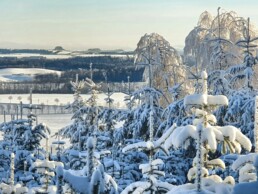BOARD 19 - THE HILL "GROSSER STEINBERG"
We find ourselves here inside the wood “Bauernbusch” at the summit’s plateau of the hill “Großer Steinberg”. With an altitude of 493.7 meters above sea level this spot is the highest point of Ruppendorf. While the thick woods on the summit are blocking the view onto the summit, the position at the edge of the wood allows an impressive panoramic view. This extends across the landscape of the surrounding villages until the hill “Steinberg” near Ruppendorf (cf. Information board 18), the woods “Höckendorfer and Paulshainer Heide”, the more than 35 kilometers distant hills table mountains within the Elbe Sandstone Mountains as well as to the heights of the Osterzgebirge near the village Kipsdorf. In the northern part of the Ruppendorf district, at the brook “Borlasbach”, we can find the lowest point with 364.2 meters above sea level.
The difference in altitude of around 130 meters leads to an average decline in temperature of about 1 degree Celsius. This effect, known as the vertical temperature gradient, describes falling temperatures with an increasing altitude. This can especially be witnessed in winter. While the lower parts of Ruppendorf still experience rain or sleet, the area around the hill “Großer Steinberg” is already covered in frost and snow.
The “Bauernbusch” wood once served as a wood for the agricultural goods of Ruppendorf which lay downriver on the left side of the former “Mühlgraben” (cf. Information board 10). Historic records such as a map by Matthias Oeder show a deteriorated field forge at the time close to the wood “Bauernbusch” and on the hill “Großer Steinberg”. The forge was used for repair works, the hardening and the production of grubbers and agricultural tools.
Geologically speaking, we find ourselves here on one of the oldest geological formations of the Erzgebirge, the “Unterer Freiberger Graugneis”. This consists predominantly of quartz, feldspar, plagioclase and biotite and was created through transformation under high pressure from already existing stones (metamorphosis). According to the Freiberger scientist Tichomirowa its creation dates back to a time 540 to 329 million years ago.

